Wistron NeWeb UMC-6270Q module User Manual HiLo3G technical specification
Wistron NeWeb Corporation module HiLo3G technical specification
User Manual.pdf

Product specification
1
Wistron NeWeb Corp.
CONFIDENTIAL
THIS DOCUMENT CONTAINS PROPRIETARY TECHNICAL INFORMATION, WHICH IS THE PROPERTY OF
THE WISTRON NEWEB CORPORATION AND SHALL NOT BE DISCLOSED TO OTHERS IN WHOLE OR IN
PART, REPRODUCED, COPIED, OR USED AS THE BASIS FOR DESIGN, MANUFACTURING, OR SALE OF
APPARATUS WITHOUT WRITTEN PERMISSION OF WISTRON NEWEB CORPORATION.
UMC-6270QV
User Guide
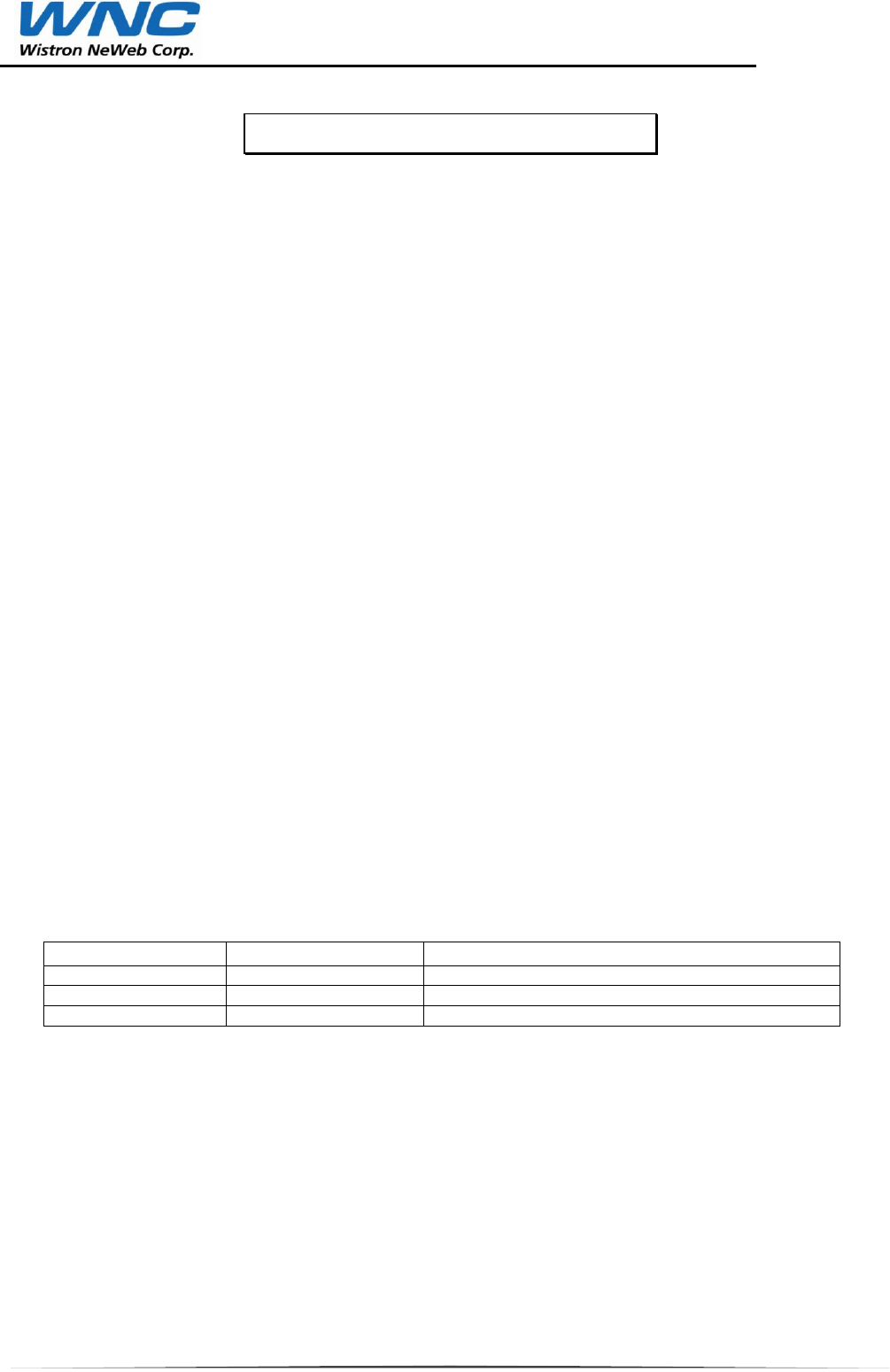
Product specification
2
CONTENTS
CONTENTS .......................................................................................................................................................................... 2
1. INTRODUCTION ...................................................................................................................................................... 3
1.1 PRODUCT CONCEPT ........................................................................................................................................ 3
1.2 STANDARDS ....................................................................................................................................................... 3
1.3 TERMS AND ABBREVIATION ......................................................................................................................... 4
1.4 CONVENTIONS ................................................................................................................................................... 4
1.5 PRODUCT FEATURES OVERVIEW ............................................................................................................... 5
2. BLOCK DIAGRAM & PIN ASSIGNMENT ........................................................................................................... 7
3. RF AIR INTERFACES AND PERFORMANCE ................................................................................................ 14
3.1 RF AIR INTERFACE AND BAND CONFIGURATION ................................................................................ 14
3.1.1 Air interfaces ............................................................................................................................................. 14
3.2 RF PERFORMANCE ......................................................................................................................................... 14
3.3 TRANSMITTER POWER CLASS ................................................................................................................... 14
4. OPERATING CONDITIONS ................................................................................................................................ 15
4.1 ABSOLUTE MAXIMUM RATINGS ................................................................................................................. 15
4.2 RECOMMENDED OPERATING CONDITION .............................................................................................. 16
5. CURRENT CONSUMPTION ................................................................................................................................ 17
6. APPLCATION DESIGN NOTES ......................................................................................................................... 18
6.1 LAYOUT NOTES .................................................................................................................................. 18
7. MECHANICAL REQUIREMENTS ...................................................................................................................... 20
7.1 MODULE DIMENSION AND FOOTPRINT.................................................................................................... 20
8. CERTIFICATION REQUIREMENTS ................................................................................................................ 22
8.1 CARRIER CERTIFICATION REQUIREMENTS ........................................................................................... 22
8.2 REGULATORY COMPLIANCE ..................................................................................................................... 22
8.3 FCC WARNING STATEMENT ........................................................................................................................ 22
Revision history
Revision
Date
Description
V1.0
April 7 2014
Initial release
V2.0
May 13 2014
Modify recommended operating condition
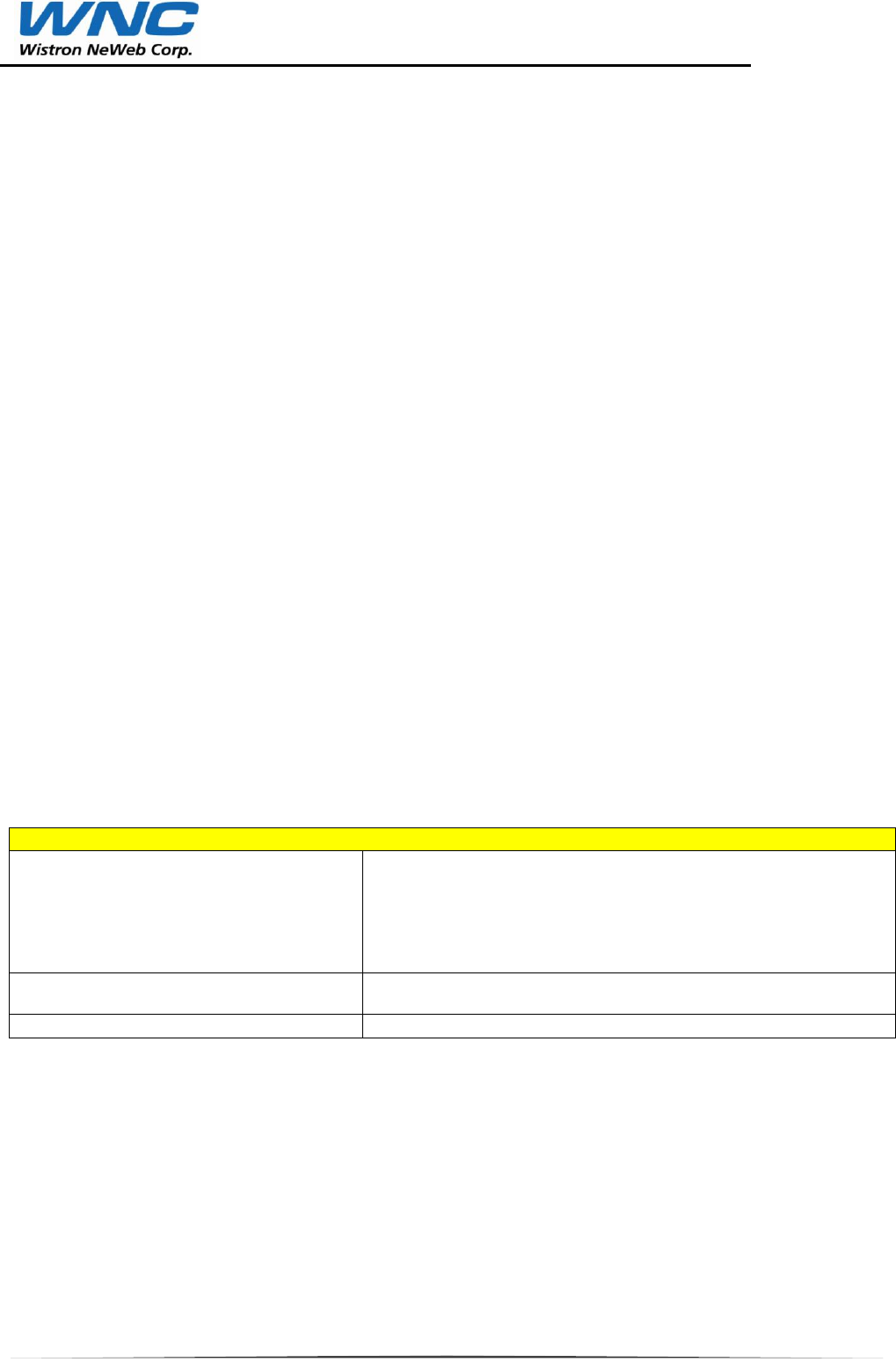
Product specification
3
1. INTRODUCTION
This document describes the hardware interface of the WNC Small Form Factor (SFF) module used to connect
the device application and the air interface.
Two versions of Small Form Factor (SFF) module are described in this specification document as follows:
UMC-6270QV - HSDPA
1.1 PRODUCT CONCEPT
The SFF module is one of the smallest available WCDMA HSDPA of the market. The target application is the
Machine to Machine (M2M) market including automotive, AMM (Automatic Metering Management), tracking
system, Alarm, Healthcare/monitoring, Telematics etc. Despite its small size and cost,
In addition to its size it has the following outstanding characteristics:
Minimum low power consumption in idle mode: 1.4mA
High input voltage range: 3.4 V to 4.2 V
USB High Speed
Digital Audio PCM
Full set of AT commands as well as analogue and Digital audio interface.
In addition to the module, a complete development kit can be provided for customers.
1.2 STANDARDS
This product, together with its evaluation board, is in compliance with the directives and standards listed below:
Directives
FCC
RF : FCC Part 22H (850 Band )
FCC Part 24E (for 1900 Band)
FCC Part 22 Subpart H:
Cellular Radiotelephone Service; Subpart I: Offshore
Radiotelephone Service;
FCC Part 24 E: Personal Communications Service; Subpart E:
Broadband PCS.
EMI: FCC Part 15B
Subpart B - Radio frequency devices subpart B – Unintentional
Radiators
SAR(MPE) : OET65C

Product specification
4
1.3 TERMS AND ABBREVIATION
ADC Analog to Digital Converter
CODEC Coder-Decoder
CLIP Calling Line Identification Presentation
COLP Connected Line Identification Presentation
CLIR Calling Line Identification Restriction
COLR Connected Line Identification Restriction
CTS Clear To Send
CSD Circuit Switched Data
CS Codec Scheme
DCS Digital Communications System
DSR Data Set Ready
DTR Data Terminal Ready
ENS Enhanced network selection
EONS Enhanced operator name string
ESD Electrostatic Discharge
ETS European Telecommunication Standard
FAX Facsimile
HSCSD High Speed Circuit Switched Data
HSDPA High Speed Downlink Packet Access
IC Integrated Circuit
IEEE Institute of Electrical and Electronics Engineers
I/O Input / Output
ISO International Standards Organization
ITU International Telecommunication Union
JTAG Joint Test Action Group
Kbps kilobit per second
LCD Liquid Crystal Display
LED Light Emitting Diode
Mbps Megabit per second
PBCCH Packet Broadcast Channel
PCB Printed Circuit Board
PCM Pulse Code Modulation
PCS Personal Communication System
PWM Pulse Width Modulation
RAM Random Access Memory
RF Radio Frequency
RI Ring Indication
RMS Root Mean Square
RTS Ready To Send
RX Reception
SIM Subscriber Identification Module
SMS Short Message Service
TBC To Be Confirmed
TBD To Be Defined
TX Transmission
UART Universal Asynchronous Receiver and Transmitter
UMTS Universal Mobile Telecommunications System
USB Universal Serial Bus
USIM Universal Subscriber Identity Module
USSD Unstructured Supplementary Service Data
1.4 CONVENTIONS
Throughout this document, DTE (data terminal equipment) indicates the equipment which masters and controls
the module device by sending AT commands via its serial interface.
DCE (data communication equipment) indicates the module device.
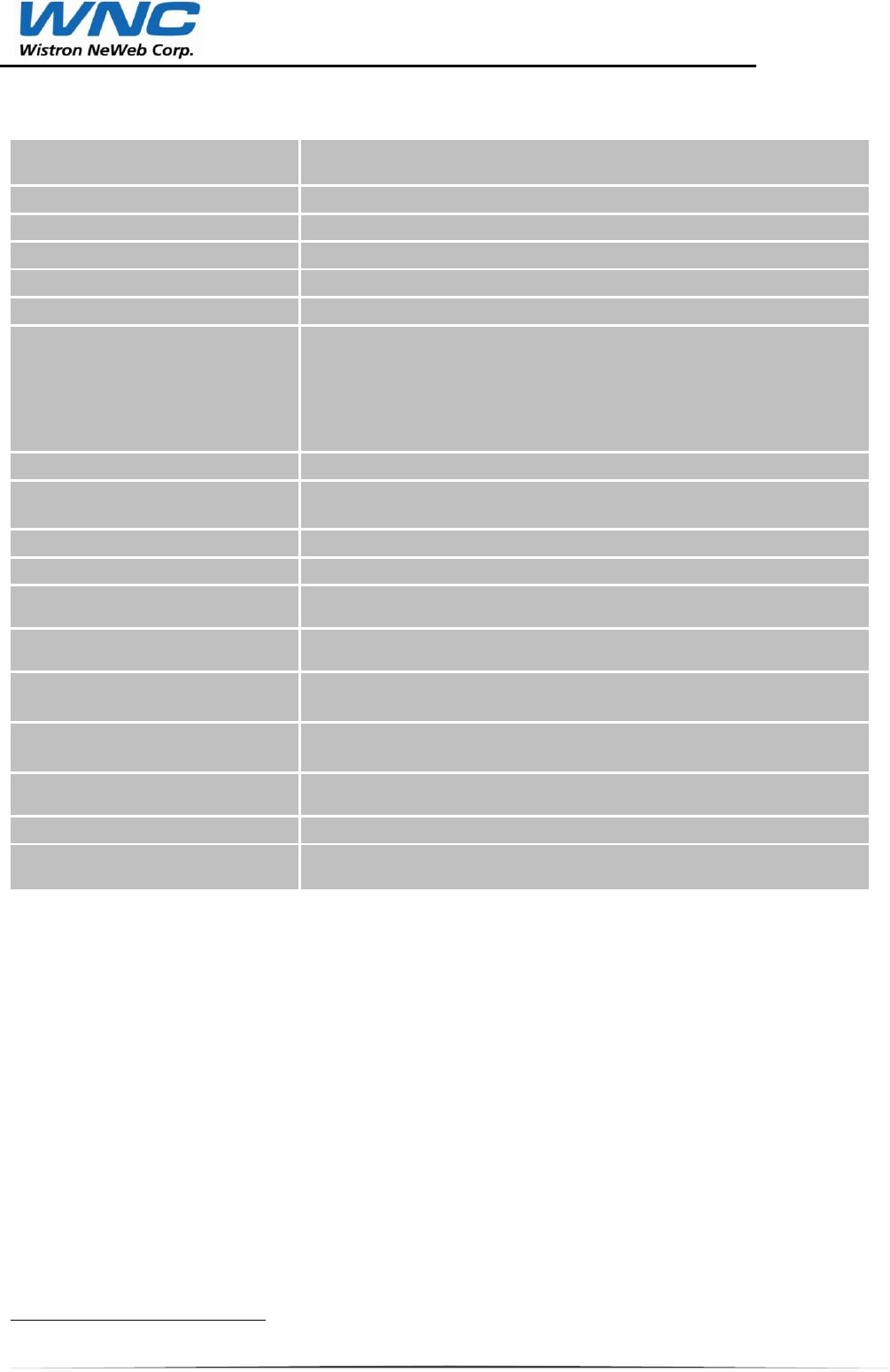
Product specification
5
1.5 PRODUCT FEATURES OVERVIEW
Temperature range
Normal range: -25°C to +85°C
Storage: -40°C to +85°C
Weight
6 g (typ.)
ESD
ESD protection >= 2 kV
Physical dimensions
22.1 x 25.1 x 2.65 mm (typical)
Connection
141 pin LGA type
Power supply
3.4V to 4.2V range, 3.8V nominal
Power consumption*
Off mode: 50 µA typical
Registered idle mode:
WCDMA: 1.3 mA (DRX=9)
Peak Current
WCDMA: up to 700 mA
Antenna /RF interface
Both GPS and transmitter/receiver RF are LGA Pad.
Frequency bands
WNC module supports
UMTS B2 /B5
Transmit power
Class 3 for UMTS 850/1900
Supported SIM cards
3V and 1.8V SIM cards
SIM slot
Signals for the management of the SIM card are provided on LGA
pads.
PWM
Signal for LED, vibrating device and Buzzer management is provided
on the PWM pin
Digital audio link
A digital audio interface PCM bus is provided. Master mode with 16
bits and a frequency of 2048 KHz.
Data/command multiplexing
Software management of data/command multiplexing on the serial
link UART.
USB
Supports USB High speed 480Mbps and full speed 12Mbps, with 3
logical Channels. Battery charging is achieved through USB
USIM
Use USIM controller to achieve USIM connection
Module Hardware Configuration
The SFF LGA module will support the QSC6270/6055 chipset with the configuration described below.
For UMC-6270QV module:
Key Features
• Compliant with 3GPP Rel’5 for WCDMA and HSDPA
• Max. Data Rate: 384Kbps uplink, 384Kbps downlink with WCDMA Rel’99 and 3.6Mbps
downlink with HSDPA
• Support OS: Brew Mobile Platform
• ARM9 operating at 230Mhz maximum frequency
*
The power consumption is highly dependent on the customer’s product design and the module environment.

Product specification
6
• Data interface: USB2.0 Host High Speed
• Form Factor: LGA module
Specification
• Communication Interface: (I2C x1/UART x1/USB2.0 x1/SPI x1/ SDIO x2)
• Support HSDPA (DL 3.6Mbps/UL 384Kbps)
• Supported SIM cards (3V and 1.8V SIM cards)
• USIM interface
• General purpose I/O pins ( x25)
• Audio Interface (PCM/ I2S)
• MCP (DDR 512Mb + 1Gb NAND)
• Support GPS
• RF interface: 2 RF pads for WCDMA TX/RX, and GPS.
WCDMA/HSDPA Support Bands
• Band 2 and Band 5
WCDMA Power Class
• Class3 (24dBm +1/-3 dB)
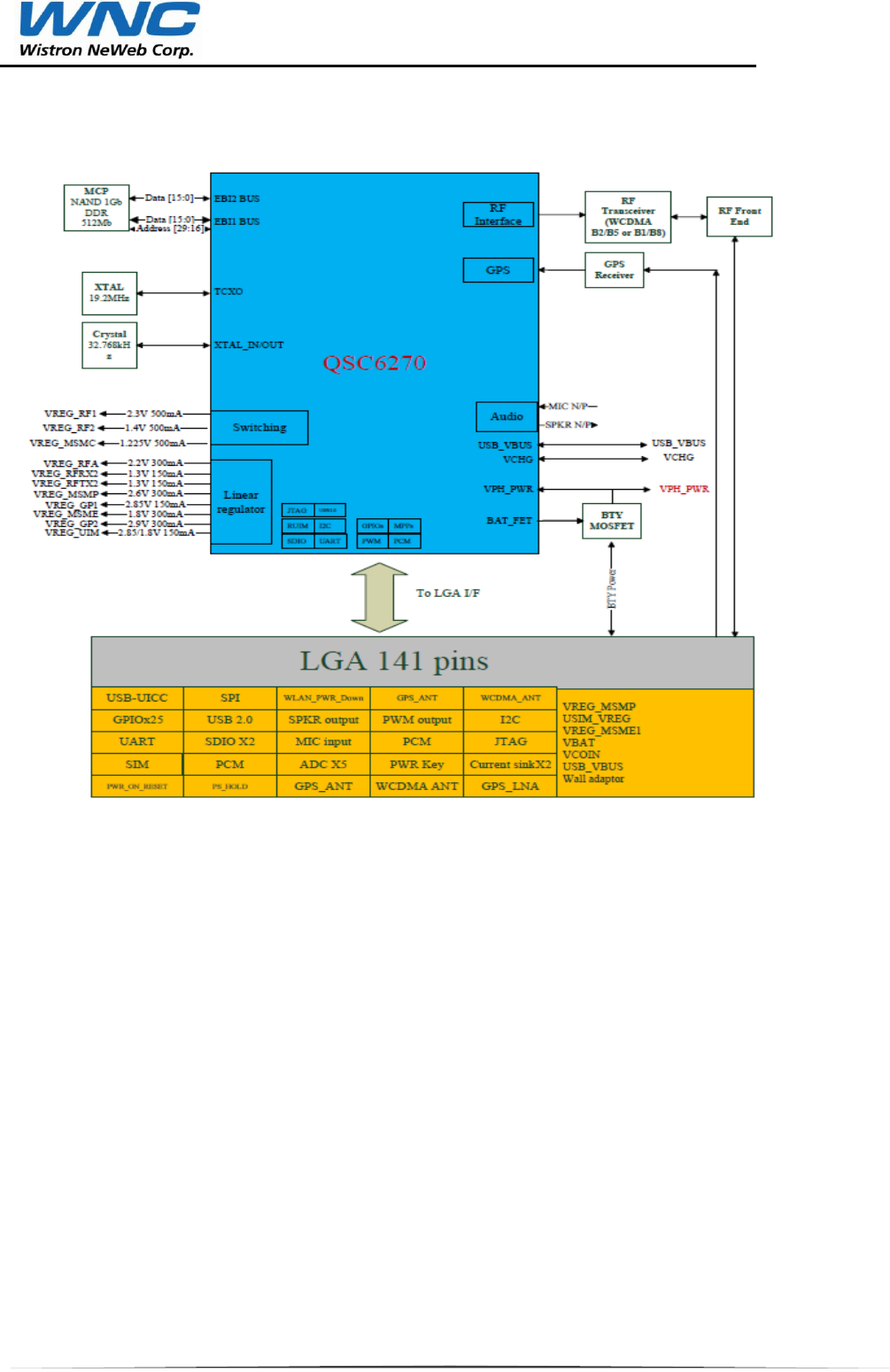
Product specification
7
2. BLOCK DIAGRAM & PIN ASSIGNMENT
Pin Definition 4
This section is intended to capture the final LGA pin out for the SFF Module.
The interfaces with a SFF module are all through a 141-pin surface LGA pad, as shown in Figure 2-1.
For UMC-6270QV module:
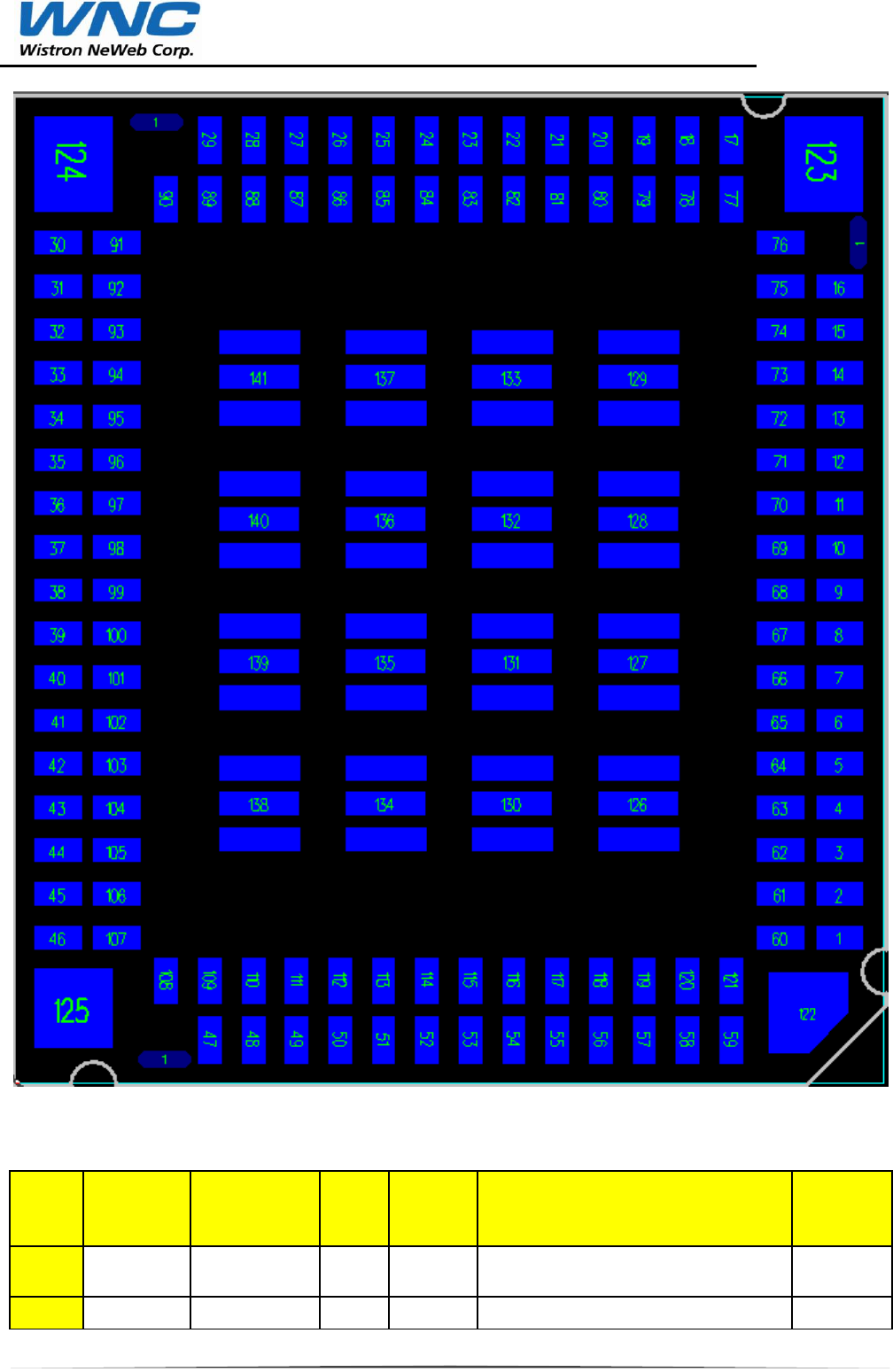
Product specification
8
Figure 2-1: UMC-6270QV module
Pin
numbe
r
Category
pin name
Pad
group
Pad type
Description
Driving
capacity
1
RF
WCDMA_A
NT
AI,AO
WCDMA antenna signal
2
GND
GND
GND
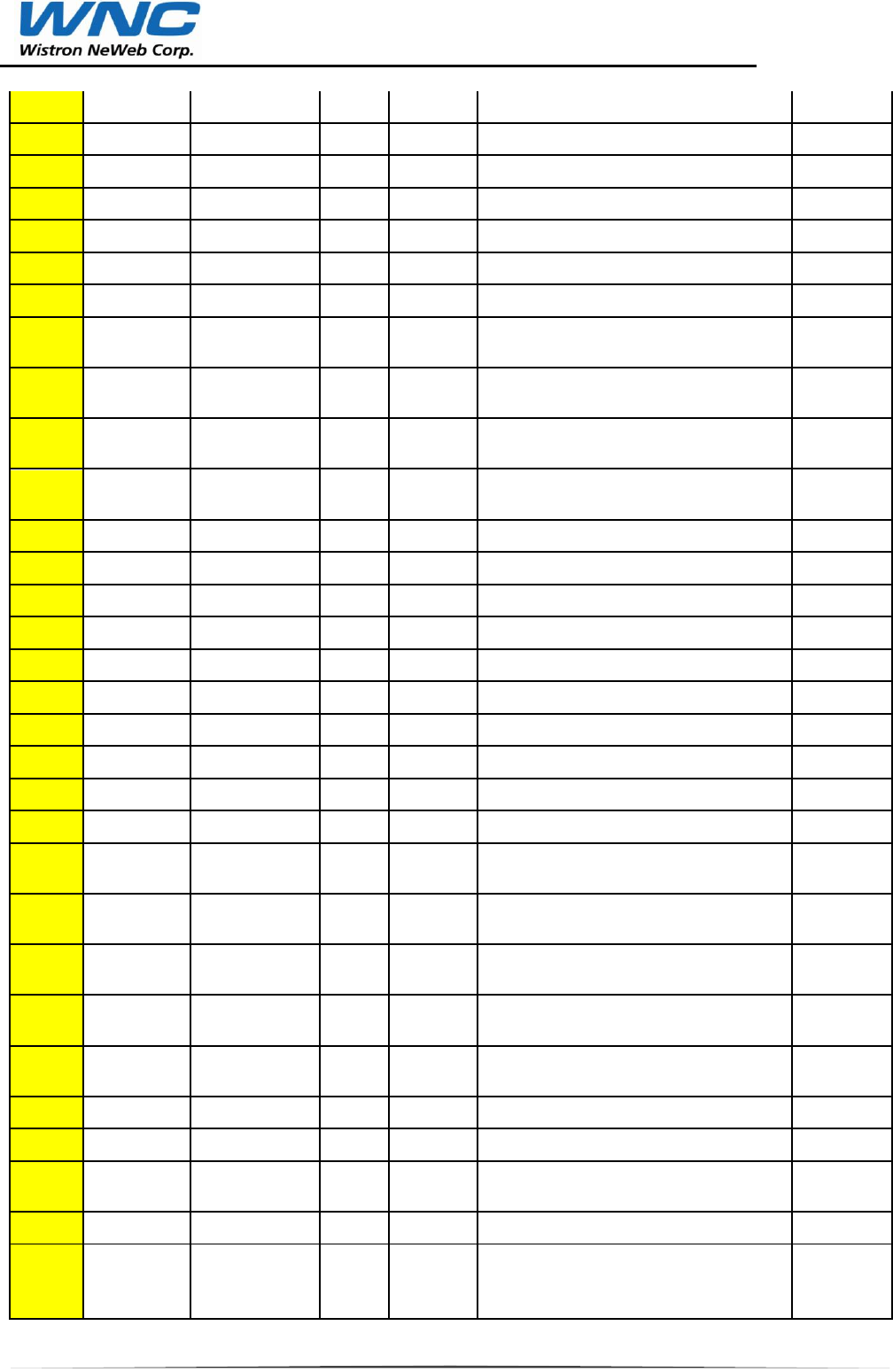
Product specification
9
3
GPIO
GPIO9
1.8V
I/O, PD
Configurable I/O
1-8mA
4
GPIO
GPIO2
1.8V
I/O, PD
Configurable I/O
1-8mA
5
GPIO
GPIO5
1.8V
I/O, PD
Configurable I/O
1-8mA
6
GPIO
GPIO8
1.8V
I/O, PD
Configurable I/O
1-8mA
7
I2C
I2C_SCL
1.8V
I/O
I2C clock
8
PCM
PCM_BCLK
1.8V
DO
Clock for the PCM interface
9
PCM
PCM_SYNC
1.8V
DO
PCM interface sync
10
PCM
PCM_DIN
1.8V
DI
PCM I/F data in (if UMC-6270QV
master)
11
PCM
PCM_DOUT
1.8V
DO
PCM I/F data out (if UMC-6270QV
master)
12
GPS_LNA_E
N
1.8V
I/O, PU
Configurable I/O
1-8mA
13
SPI
SPI_CS_N
1.8V
DO
Serial peripheral interface chip-
select
14
SPI
SPI_CLK
1.8V
DO
Serial peripheral interface clock
15
GND
GND
GND
16
GND
GND
GND
17
RF
GPS_ANT
AI
GPS antenna signal
18
GND
GND
GND
19
GPIO
GPIO21
1.8V
I/O, PU
Configurable I/O
20
GND
GND
GND
21
GPIO
GPIO20
1.8V
I/O, PU
Configurable I/O
1-8mA
22
GPIO
GPIO16
1.8V
I/O, PU
Configurable I/O
1-8mA
23
GPIO
GPIO17
1.8V
I/O, PU
Configurable I/O
1-8mA
24
SDIO2
SDCC2_DAT
A2
2.6V
I/O
SDIO2 data bit 2
2-16mA
25
SDIO2
SDCC2_DAT
A3
2.6V
I/O
SDIO2 data bit 3
2-16mA
26
SDIO1
SDCC1_CM
D
2.6V
I/O
SDIO1 command bit
2-16mA
27
SDIO1
SDCC1_DAT
A3
2.6V
I/O
SDIO1 data bit 3
2-16mA
28
SDIO1
SDCC1_DAT
A2
2.6V
I/O
SDIO1 data bit 2
2-16mA
29
GPIO
GPIO10
1.8V
I/O, PU
Configurable I/O
1-8mA
30
GND
GND
GND
31
UICC
USIM_CLK
1.8V/2
.85V
DO
USIM clock
32
USB
USB_ID
AI
High-speed USB identification line
33
power
input/outpu
t
VBAT_BB
3.7V~
4.2V
P
Input power for BB section, could
connect this pin with VBAT_RF
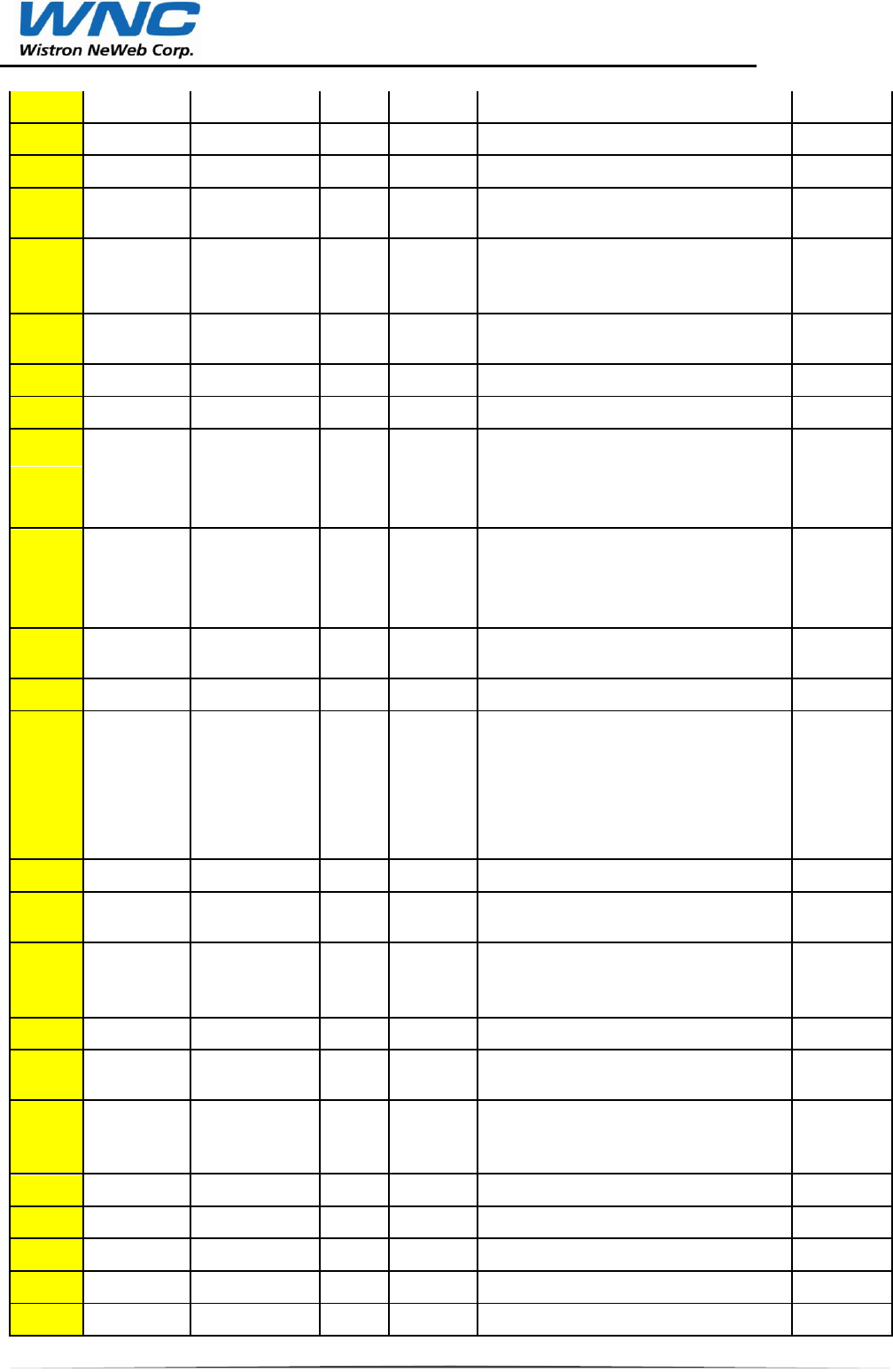
Product specification
10
34
JTAG
JTAG_TMS
1.8V
DI, PU
JTAG test mode select
35
JTAG
JTAG_RTCK
1.8V
DO
JTAG return clock
36
JTAG
JTAG_TCK
1.8V
DI, PU
JTAG clock input
37
UICC
USIM_DAT
1.8V/2
.85V
I/O
USIM data
38
power input
USB_VBUS
P
External supply voltage; connect
directly to the external USB power
supplier
39
power
output
USIM_VREG
1.8V/2
.85V
P
Output of the linear regulators
150mA
40
GND
GND
GND
41
GND
GND
GND
42
power input
VCHG
P
External supply voltage; connect
both pins directly to the external
power supply (such as a wall
charger).
43
power input
VCHG
P
External supply voltage; connect
both pins directly to the external
power supply (such as a wall
charger).
44
power
output
VREG_MSM
E
1.8V
300mA
Output of the linear regulators
45
GND
GND
GND
46
power
input/outpu
t
VCOIN
P
Used as an analog input from the 3
V coin cell for SMPL, RTC,and
crystal oscillator backup; a
capacitor (rather than a coin cell)
can be used if only SMPL is
supported
47
GND
GND
GND
48
ADC in
MPP3
AI,AO,
DI, DO
multipurpose pin
49
other
PON_REST_
N
1.8V
DO
Connected internally to RESIN_N;
logic low causes the baseband
circuits to reset.
50
GND
GND
GND
51
ADC in
BATT_THER
M
AI
connect to battery package thermal
pin
52
GND
GND
GND
53
microphone
MIC_P
AI
Microphone #1 input (+)
54
microphone
MIC_M
AI
Microphone #1 input (-)
55
GND
GND
GND
56
GPIO
GPIO4
1.8V
I/O, PD
Configurable I/O
1-8mA
57
GPIO
GPIO6
1.8V
I/O, PU
Configurable I/O
1-8mA
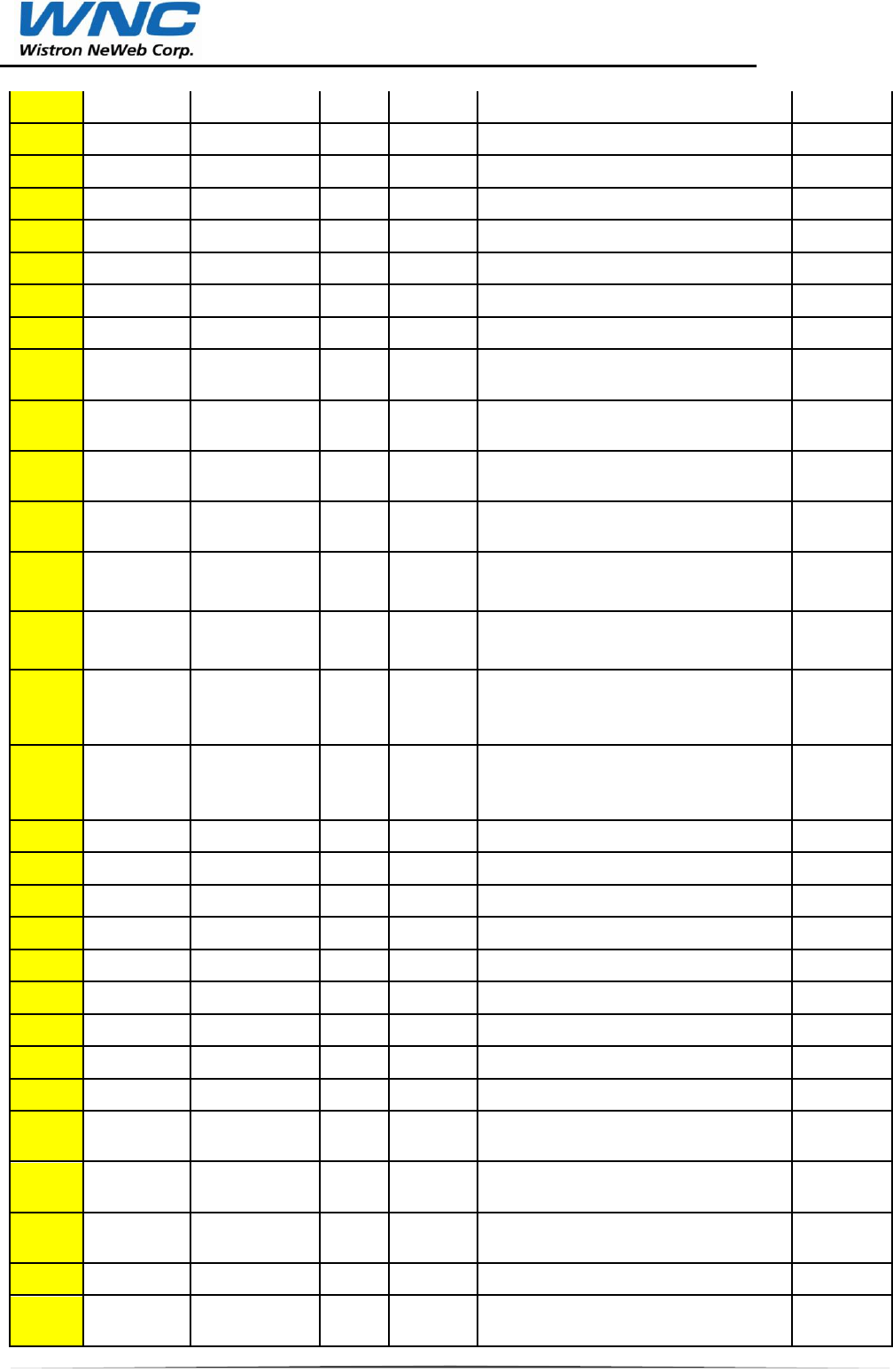
Product specification
11
58
GPIO
GPIO11
1.8V
I/O, PD
Configurable I/O
1-8mA
59
GPIO
GPIO24
1.8V
I/O, PD
Configurable I/O
1-8mA
60
GND
GND
GND
61
GPIO
GPIO18
1.8V
I/O, PD
Configurable I/O
1-8mA
62
GPIO
GPIO15
1.8V
I/O, PD
Configurable I/O
1-8mA
63
GPIO
GPIO7
1.8V
I/O, PD
Configurable I/O
1-8mA
64
GPIO
GPIO1
1.8V
I/O, PD
Configurable I/O
1-8mA
65
I2C
I2C_SDA
1.8V
I/O
I2C data
66
UART
UART_TX
1.8V
DO
High-speed UART transmit data
output
67
UART
UART_RFR
1.8V
DO
High-speed UART ready for
receive signal
68
UART
UART_RX
1.8V
DI
High-speed UART receive data
input
69
UART
UART_CTS
1.8V
DI
High-speed UART clear to send
signal
70
power input
VBAT_RF
3.7V~
4.2V
P
Input power for RF section, could
connect this pin with VBAT_BB
71
power input
VBAT_RF
3.7V~
4.2V
P
Input power for RF section, could
connect this pin with VBAT_BB
72
SPI
SPI_MOSI
1.8V
DO
SPI (master only) master out/slave
in
data
73
SPI
SPI_MISO
1.8V
DI
SPI (master only) master in/slave
out
data
74
GND
GND
GND
75
GND
GND
GND
76
GND
GND
GND
77
GND
GND
GND
78
GND
GND
GND
79
GPIO
GPIO22
1.8V
I/O, PU
Configurable I/O
80
GPIO
GPIO23
1.8V
I/O, PU
Configurable I/O
1-8mA
81
GPIO
GPIO19
1.8V
I/O, PU
Configurable I/O
1-8mA
82
GPIO
GPIO14
1.8V
I/O, PU
Configurable I/O
1-8mA
83
SDIO2
SDCC2_DAT
A0
2.6V
I/O
SDIO2 data bit 0
2-16mA
84
SDIO2
SDCC2_CM
D
2.6V
I/O
SDIO2 command bit
2-16mA
85
SDIO2
SDCC2_DAT
A1
2.6V
I/O
SDIO2 data bit 1
2-16mA
86
SDIO2
SDCC2_CLK
2.6V
DO
Output clock for SDIO2 device
2-16mA
87
SDIO1
SDCC1_DAT
A0
2.6V
I/O
SDIO1 data bit 0
2-16mA
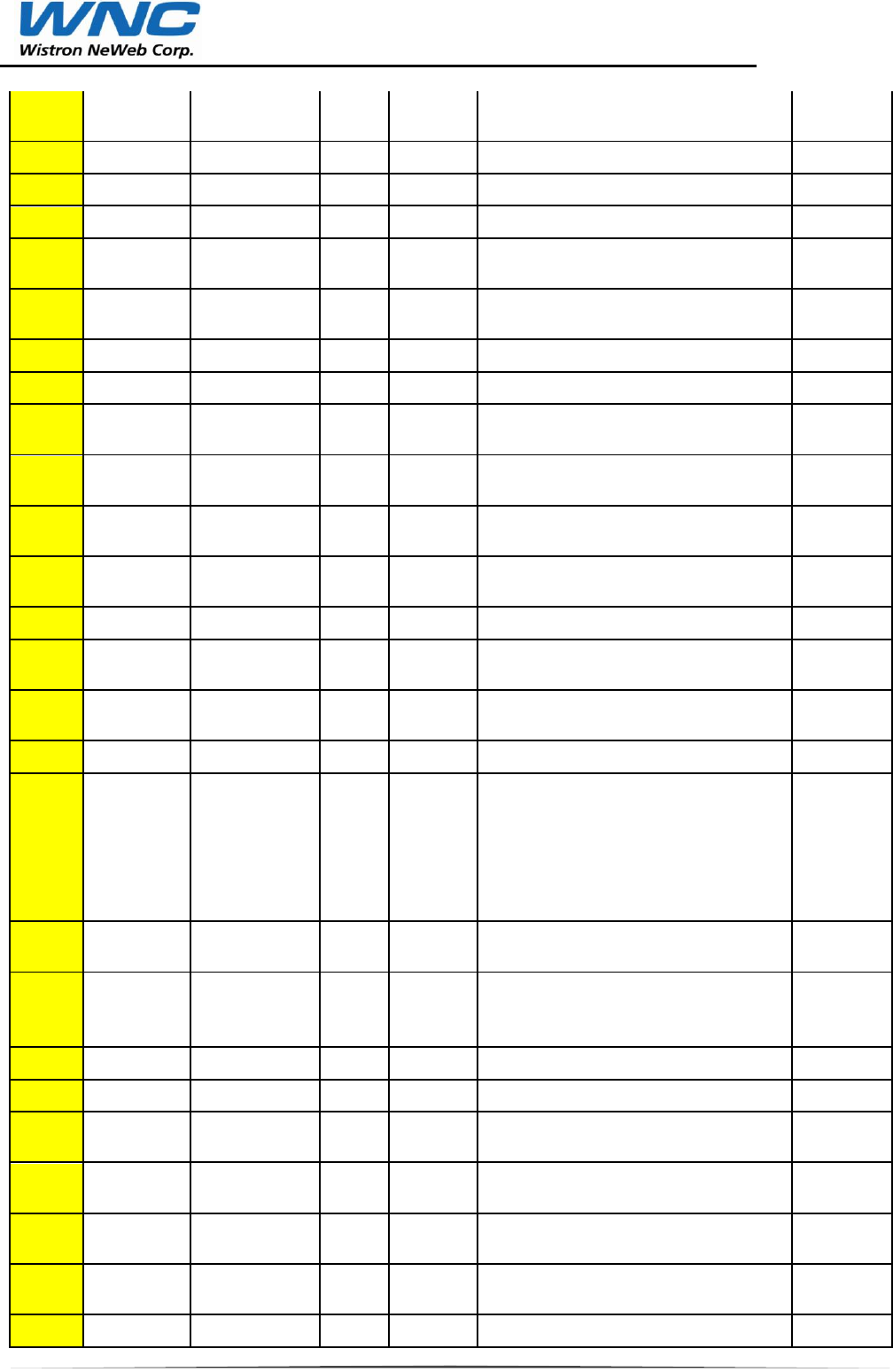
Product specification
12
88
SDIO1
SDCC1_DAT
A1
2.6V
I/O
SDIO1 data bit 1
2-16mA
89
SDIO1
SDCC1_CLK
2.6V
DO
Output clock for SDIO1 device
2-16mA
90
GPIO
GPIO3
1.8V
I/O, PU
Configurable I/O
1-8mA
91
GND
GND
GND
92
WLAN_PWR
_DOWN
2.6V
I/O, PU
Configurable I/O
2-16mA
93
UICC
USIM_RST
1.8V/2
.85V
DO
USIM reset
94
JTAG
JTAG_TDO
1.8V
Z
JTAG test data output
95
JTAG
JTAG_TDI
1.8V
DI, PU
JTAG test data input
96
power
output
VREG_MSM
P
2.6V
Output of the linear regulators
300mA
97
JTAG
JTAG_TRST
_N
1.8V
DI, PD
JTAG reset
98
USB UICC
USIM_D_P
1.8V/2
.85V
I/O
USB-UICC data plus line
99
USB UICC
USIM_D_M
1.8V/2
.85V
I/O
USB-UICC data minus line
100
GND
GND
GND
101
USB
USB_D_M
AI,AO
High-speed USB differential data,
(-) side
102
USB
USB_D_P
AI,AO
High-speed USB differential data,
(+) side
103
GND
GND
GND
104
power on
key
MSM_PON
1.8V
AI.PU
Connect to the keypad power
button. This signal is pulled up
internally to dVDD. When the QSC
device is off, pulling this pin low
initiates a powerup and generates an
interrupt.
105
ADC in
MPP4
AI,AO,
DI, DO
multipurpose pin
106
other
D2D_PS_HO
LD
DI
Baseband circuits drive this input
high to keep power on, low to shut
down
107
GND
GND
GND
108
GND
GND
GND
109
Speaker
SPKR_OUT_
P
AO
Speaker driver (+) output. Connect
directly to the speaker
500mW
110
Speaker
SPKR_OUT_
M
AO
Speaker driver (-) output. Connect
directly to the speaker
500mW
111
power
output
VREG_GP1
2.85V
P
Output of the linear regulators
150mA
112
power
output
VREG_GP2
2.9V
P
Output of the linear regulators
300mA
113
ADC in
MPP2
AI,AO,
multipurpose pin
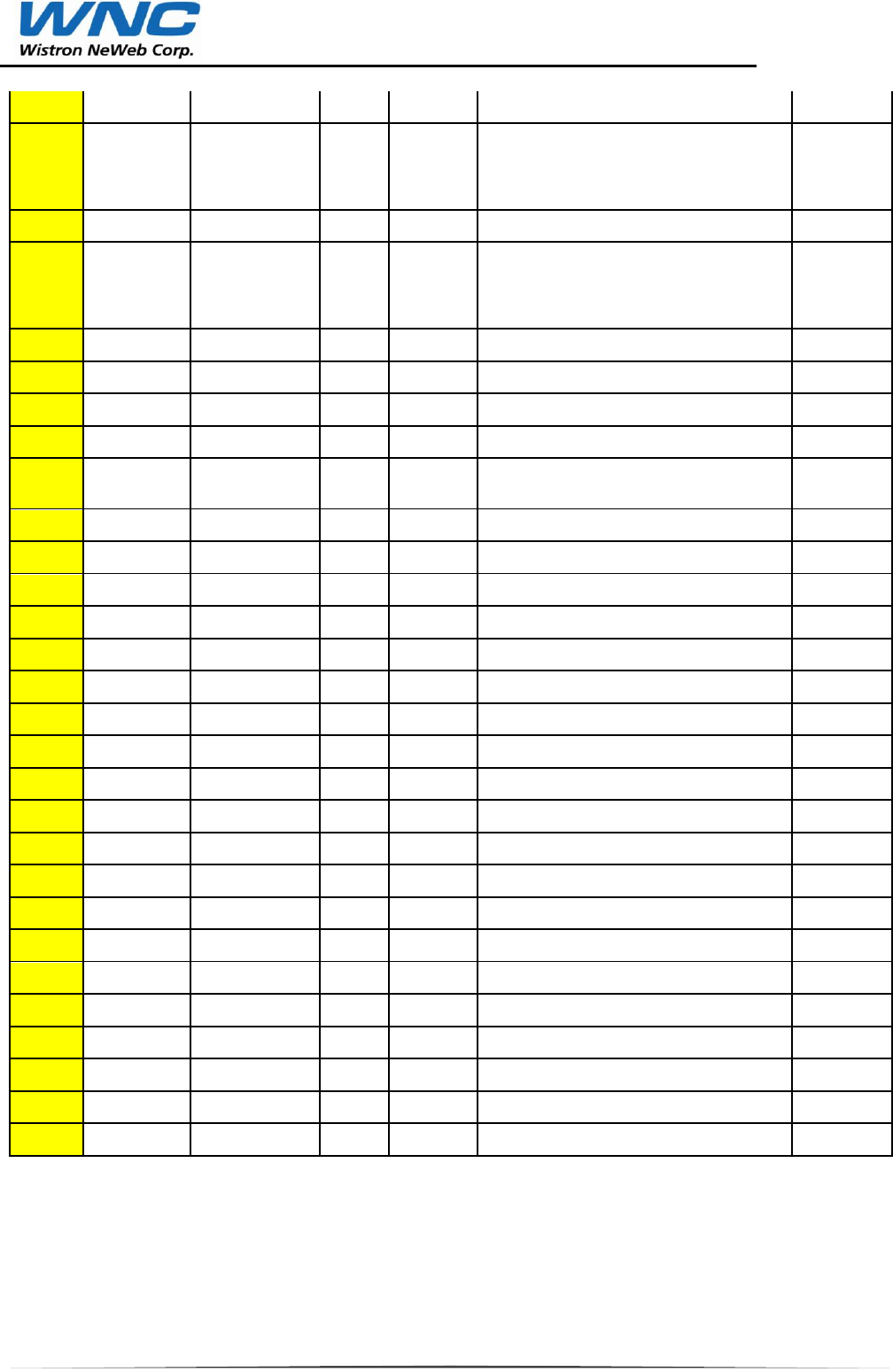
Product specification
13
DI, DO
114
current sink
VIB_DRV_N
AI
Connect to the vibration motor (-)
terminal. The (+) terminal of the
motor connects to VDD
115
ADC in
HKAIN1
AI
ADC input
116
current sink
LCD_DRV_N
AI
Connect to the LCD backlight (-)
terminal. The (+) terminal of the
LCD backlight connects to VDD
150mA
117
GND
GND
GND
118
GPIO
GPIO13
1.8V
I/O, PD
Configurable I/O
1-8mA
119
GPIO
GPIO0
1.8V
I/O, PD
Configurable I/O
1-8mA
120
GPIO
GPIO12
1.8V
I/O, PD
Configurable I/O
1-8mA
121
PDM
GP_PDM_0
2.6V
DO,PD
12-bit Pulse-density modulation
output
2-16mA
122
GND
GND
GND
123
GND
GND
GND
124
GND
GND
GND
125
GND
GND
GND
126
GND
GND
GND
127
GND
GND
GND
128
GND
GND
GND
129
GND
GND
GND
130
GND
GND
GND
131
GND
GND
GND
132
GND
GND
GND
133
GND
GND
GND
134
GND
GND
GND
135
GND
GND
GND
136
GND
GND
GND
137
GND
GND
GND
138
GND
GND
GND
139
GND
GND
GND
140
GND
GND
GND
141
GND
GND
GND
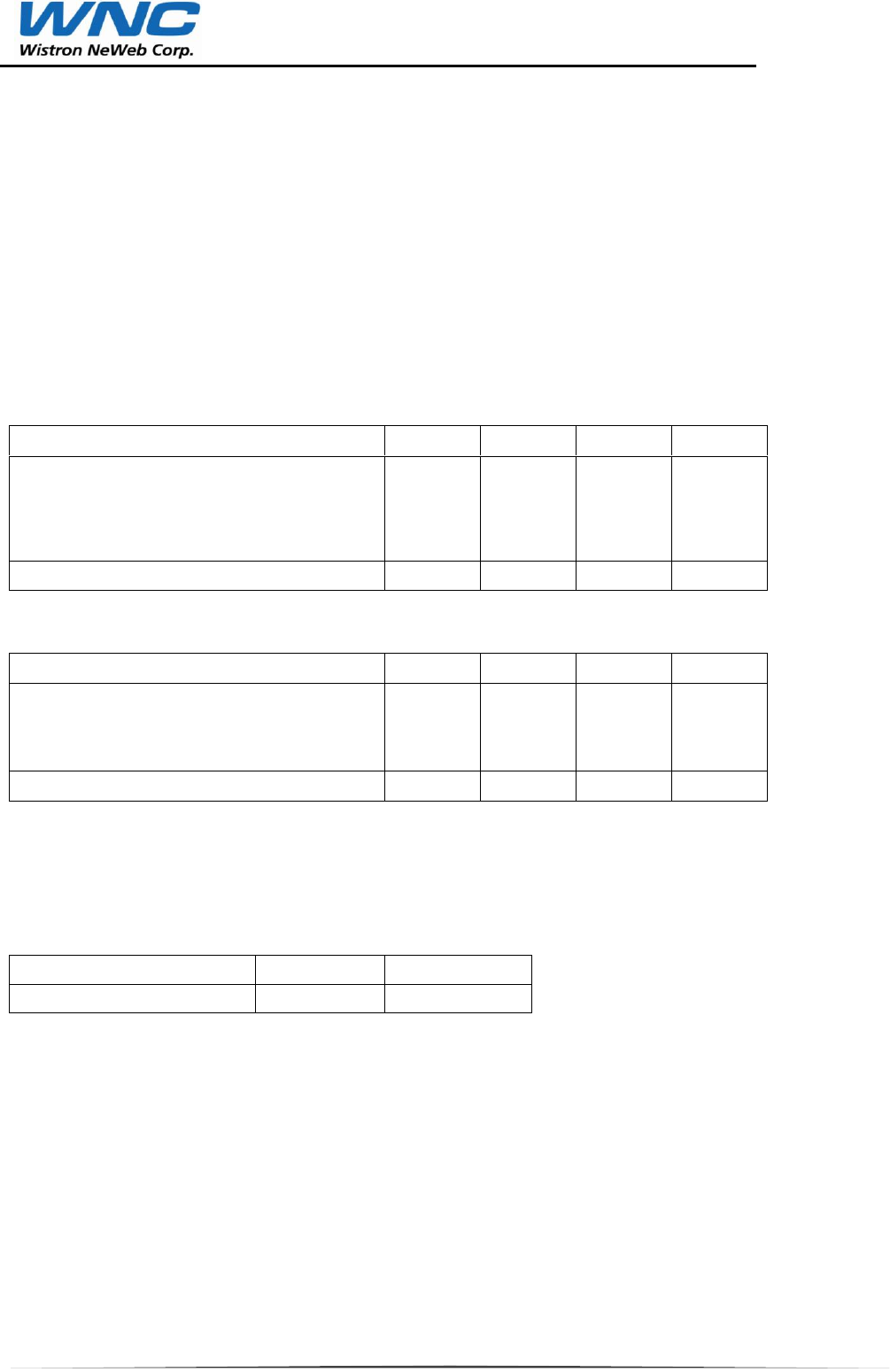
Product specification
14
3. RF AIR INTERFACES AND PERFORMANCE
3.1 RF AIR INTERFACE AND BAND CONFIGURATION
3.1.1 Air interfaces
UMC-6270QV module supports WCDMA R99, HSDPA and GPS
3.2 RF PERFORMANCE
The UMC-6270QV modules RF transmitter/receiver is fully compliant with the applicable standards. The
sensitivity and max output power are listed in Table 3-2-1 and Table 3-2-2
Specification
Min
Typ
Max
Units
UMTS Sensitivity
BC2(PCS) (1930-1990MHz Rx)
-104.7
-108
dBm
BC5(Cell) (869-894MHz Rx)
-106.7
-110
dBm
GPS Sensitivity
-155
dBm
Table 3-2-1 Conducted Receiver Sensitivity
Specification
Min
Typ
Max
Units
UMTS Max Output Power
BC2(PCS) (1850-1910MHz Tx)
23.5
dBm
BC5(Cell) (824-849MHz Tx)
23.5
dBm
GPS Sensitivity
-155
dBm
Table 3-2-2 Conducted Transmitter Max Output Power
3.3 TRANSMITTER POWER CLASS
The UMC-6270QV Modules support the power classes listed in Table 3-3
Mode
Band
Power Class
WCDMA/HSDPA
B2/B5
3
Table 3-3 Supported Power Classes
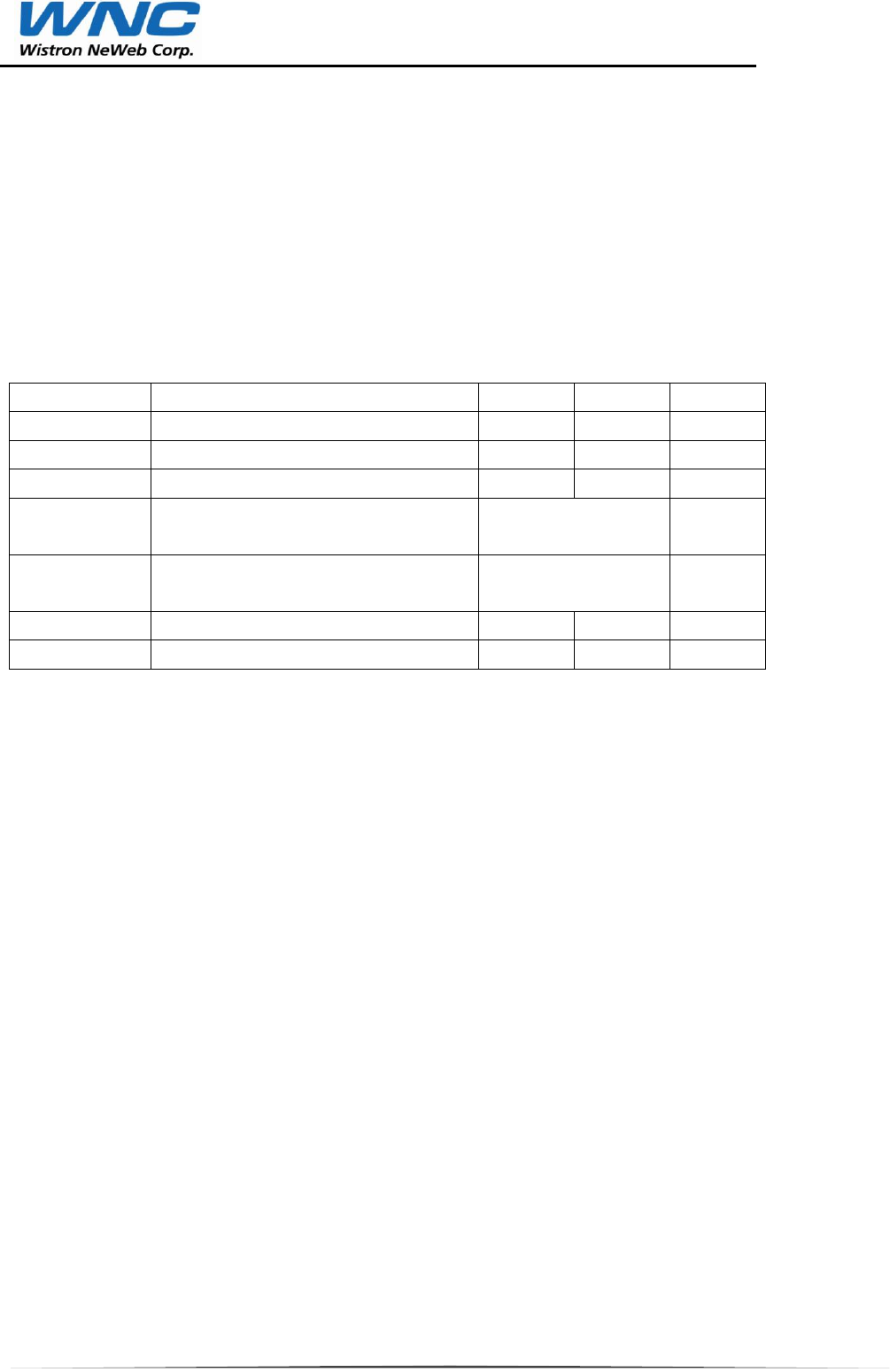
Product specification
15
4. OPERATING CONDITIONS
4.1 ABSOLUTE MAXIMUM RATINGS
Operating UMC-6270QV Modules under conditions beyond its absolute maximum ratings (Table 4-1) may
damage the device. Absolute maximum ratings are limiting values to be considered individually when all other
parameters are within their specified operating ranges. Functional operation and specification compliance under
any absolute maximum condition, or after exposure to any of these conditions, is not guaranteed or implied.
Exposure may affect device reliability.
Symbol
Parameter
Min
Max
Unit
Ts
Storage temperature
-40
85
C
USB_VBUS
DC power supply voltage
4.5
5.5
V
VBAT
Battery input voltage
3.4
4.2
V
VESD_HBM
Eletrostatic discharging voltage rating
(human body model)
*
V
VESD_CDM
Electrostatic discharge voltage rating
(charge device model)
*
V
RH_Operating
Operating humidity range
10
90
%
RH_Non-OP
Nonoperating humidity range
5
95
%
*NOTE: ESD protection should be provided external to the module.
Table 4-1 : Absolute maximum ratings

Product specification
16
4.2 RECOMMENDED OPERATING CONDITION
The devices meet all performance specifications when used within the recommended operating conditions as
described in Table 4-2
Symbol
Parameter
Min
Typ.
Max
Unit
T
Operating Temperature
-25
+85
Normal operating temperature range
See section 4.2.1
-20
+65
Extended operating temperature range 1
See section 4.2.2
-25
-20
Extended operating temperature range 2
See section 4.2.3
+65
+85
USB_VBUS
DC Power Supply Voltage
4.75
5
5.25
V
VBAT (Battery)
DC Power Supply Voltage
3.4
3.8
4.2
V
Table 4-2
4.2.1 Normal operating temperature range
The wireless module is fully functional and meets the 3GPP specification across the specified temperature
range.
4.2.2 Extended operating temperature range 1
The wireless module is fully functional across the specified temperature range. Occasional deviations from the
3GPP specification may occur.
4.2.3 Extended operating temperature range 2
The wireless module is functional across the specified temperature range. Occasional deviations from the 3GPP
specification may occur. Thermal protection including automatic shutdown is implemented for protection against
overheating.
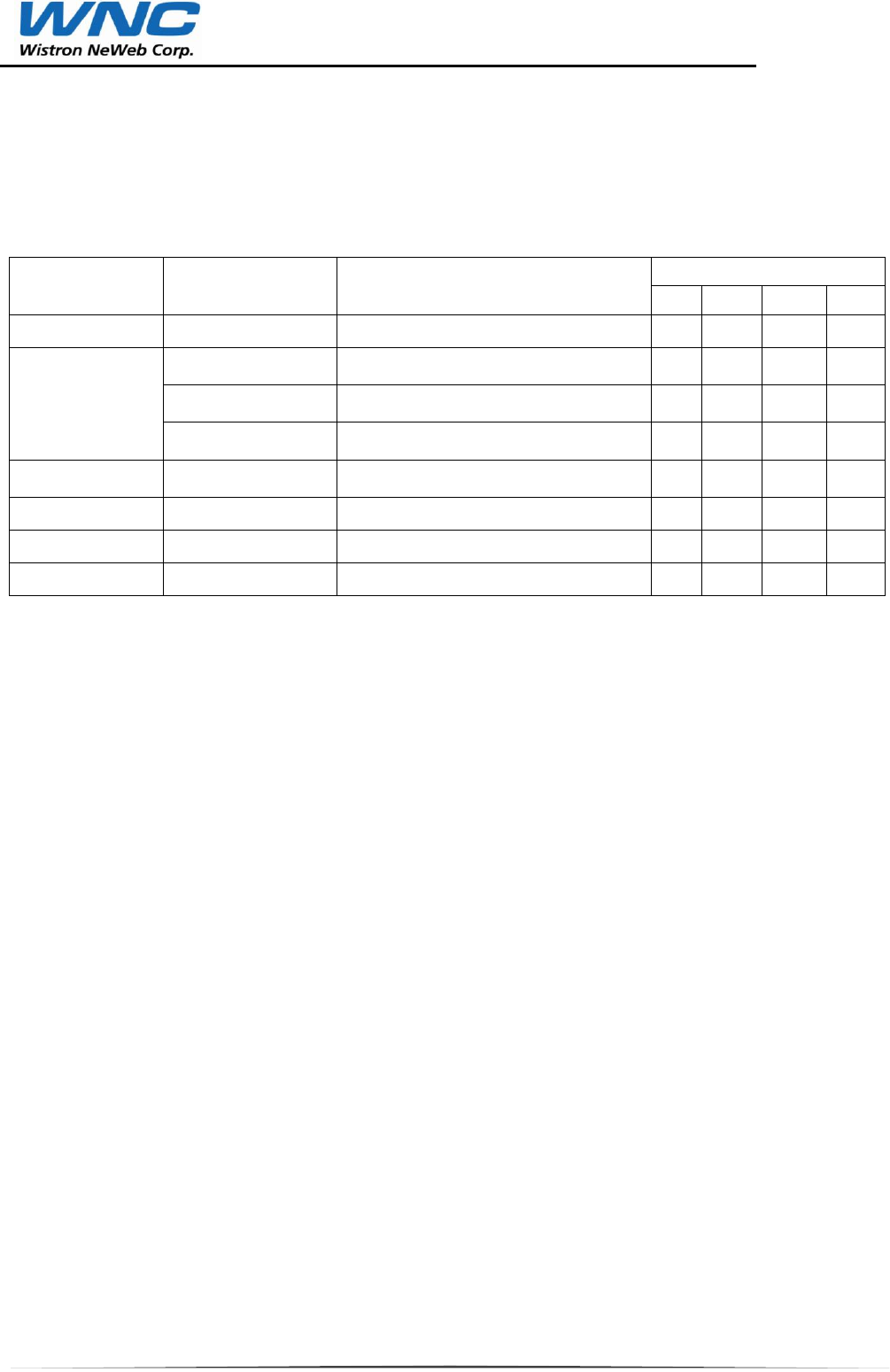
Product specification
17
5. CURRENT CONSUMPTION
The specified supply currents in Table 5-1 are based operation at room temperature. Current measurements
are taken with default parameter settings, nominal supply voltage. The DUT is mounted on a module test board
and the accelerometer on, unless otherwise noted.
Operating Modes
Description
Conditions
Average Current
Min
Typ
Max
Unit
Power Down(OFF)
VBAT voltage applied
Power Down*1,2
22
µA
WCDMA
Between Rx wakeups
Sleep*1,2
1
mA
Rx awake current
Rx Idle
57
mA
Average Sleep and Rx
Standby*3
1.6
mA
Average GPS only
Average GPS only
30
mA
HSDPA 3.6MbpsDL/384Kbps UL (0dBm)
180
mA
WCDMA Tx/Rx (23.5dBm)
550
mA
Table 5-1 Typical Power Consumption
Note 1 Measurement taken without Test Board
Note 2 Measurement taken without Accelerometer
Note 3 Value calculated from measured IUSB_AVG subtacted from
ITOTAL_GPS_AVG, I-GPS = I-Total_GPS_AVG – IUSB_AVG
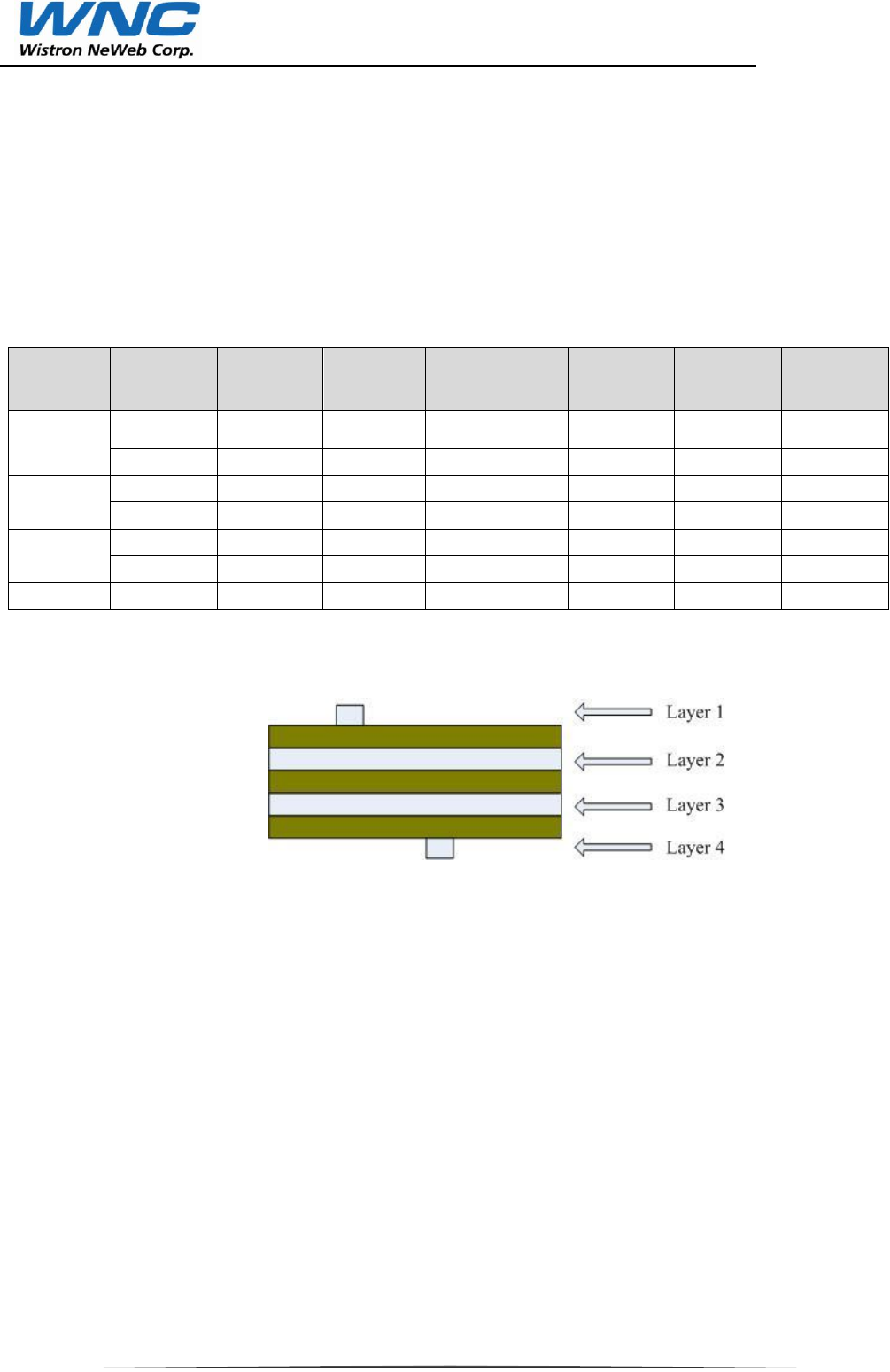
Product specification
18
6. APPLICATION DESIGN NOTES
6.1 Layout Notes
6.1.1 RF Pin Input Impedance Matching
Applications utilizing the module must ensure that a 50Ω controlled impedance trace is used. Shown in the
accompanying table are example calculations for a four- layer FR4 stack up and the resulting trace width for
Bluetooth RF input. The figure below illustrates the layer stack up for a four- layer board according to the
Description column in the table below.
Layer
Material
Type
Dielectric
Thickness
Trace
Width
Copper
Thickness
Dielectric
Constant
Char.
Impedance
Description
1
Conductive
-
27
2.1
-
50
Microstrip
Dielectric
16
-
-
4.3
-
Prepreg
2
Conductive
-
-
1.4
-
Plane
Dielectric
20
4.3
-
Prepreg
3
Conductive
-
-
1.4
-
-
Plane
Dielectric
16
-
-
4.3
-
Prepreg
4
Conductive
-
27
2.1
-
50
Microstrip
Table 6-1-1-1 Application Board Characteristic Impedance
Figure 6-1-1-1 Application Board Layer Stack Up
6.1.2 Handling Requirements
DO NOT TOUCH ANY Pad OF BTI MODULE WHILE ASSEMBLYING.
6.1.3 Soldering Requirements
Soldering Iron Soldering
Solder Temperature: 350oC
Immersion Duration: 2 ~ 3 seconds
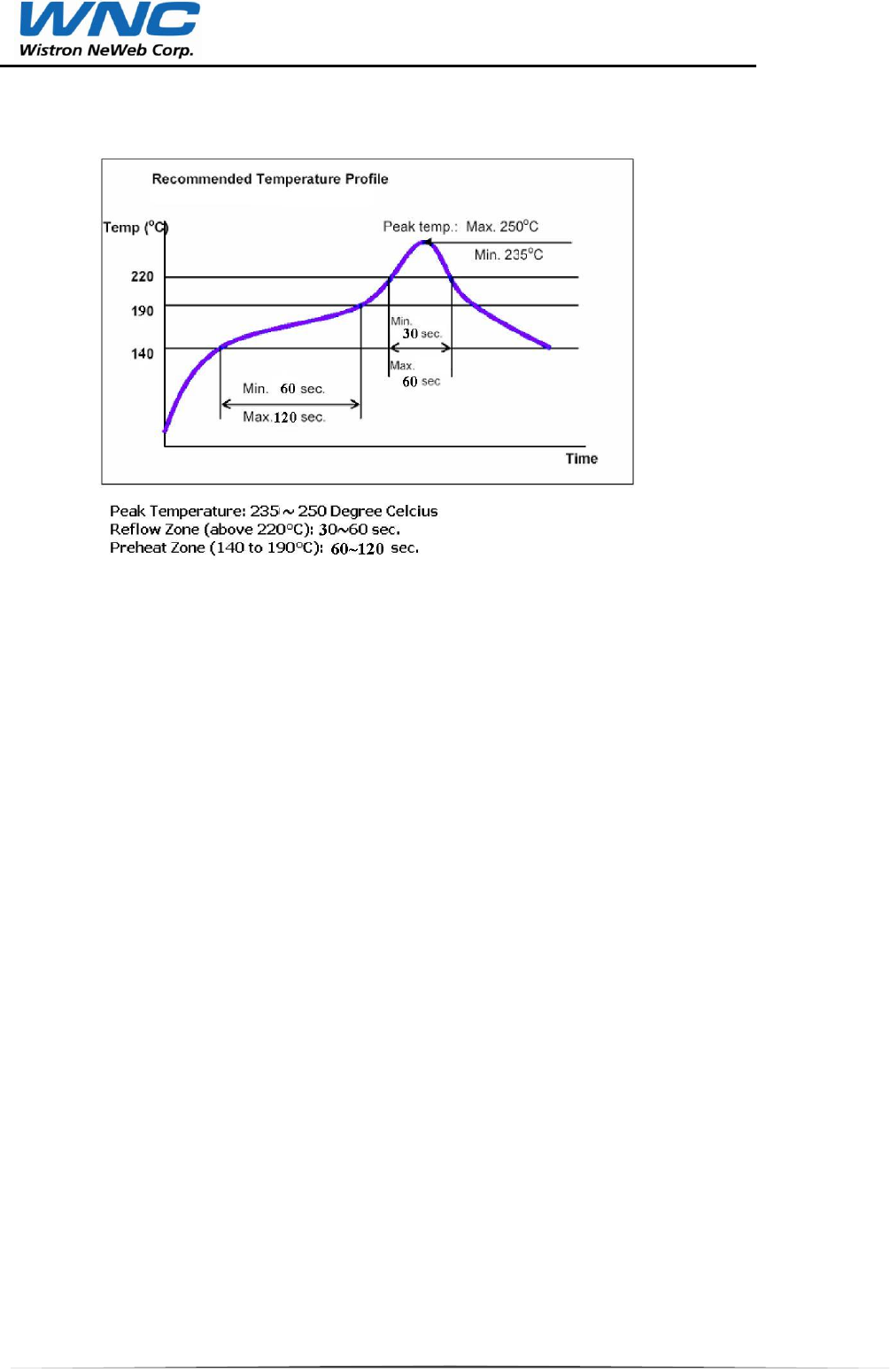
Product specification
19
6.1.4 Reflow Profile
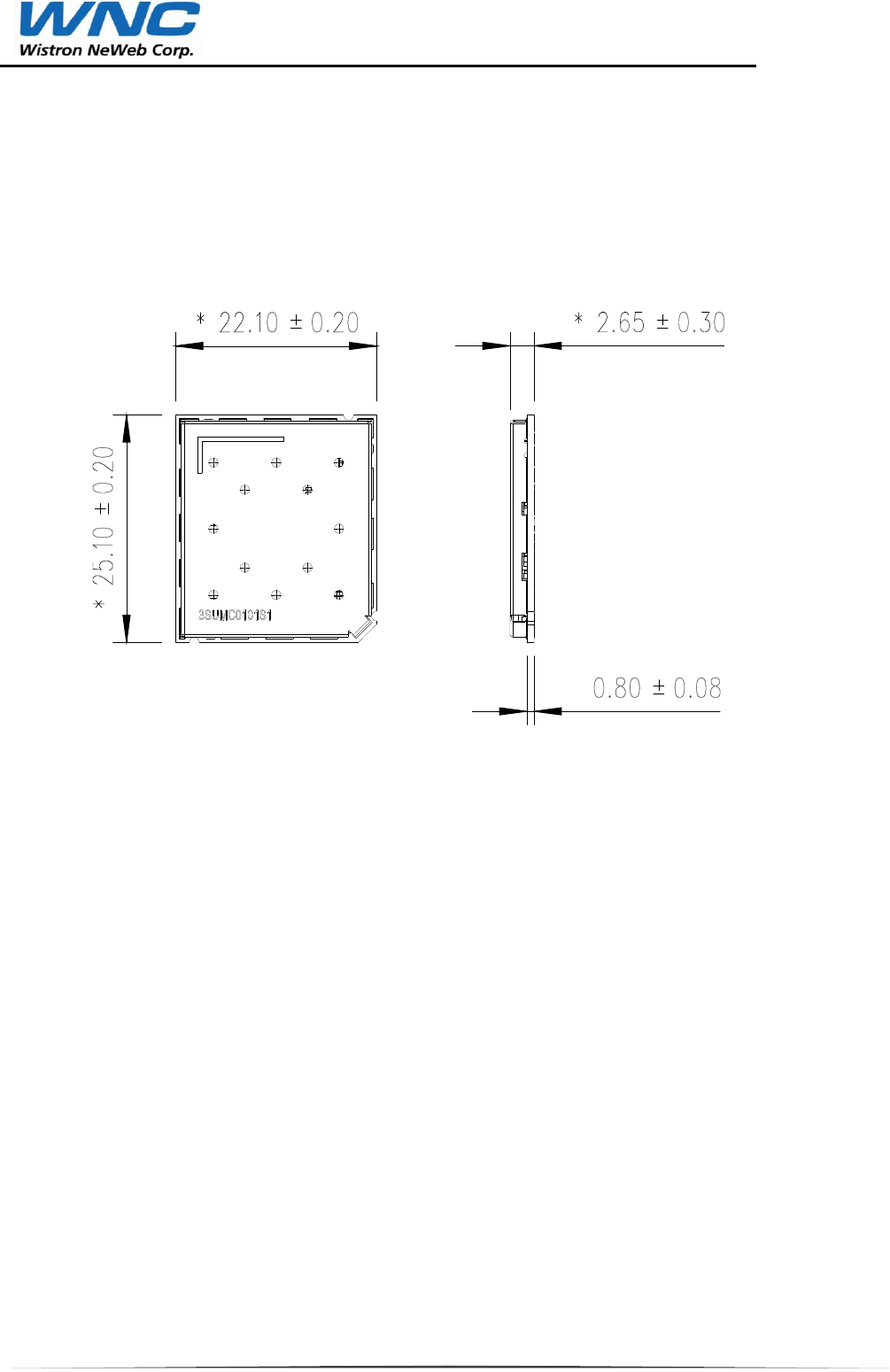
Product specification
20
7. MECHANICAL REQUIREMENTS
7.1 Module Dimension and Footprint
The dimension of this module:
Figure 7-1-1 Dimension of SFF Module
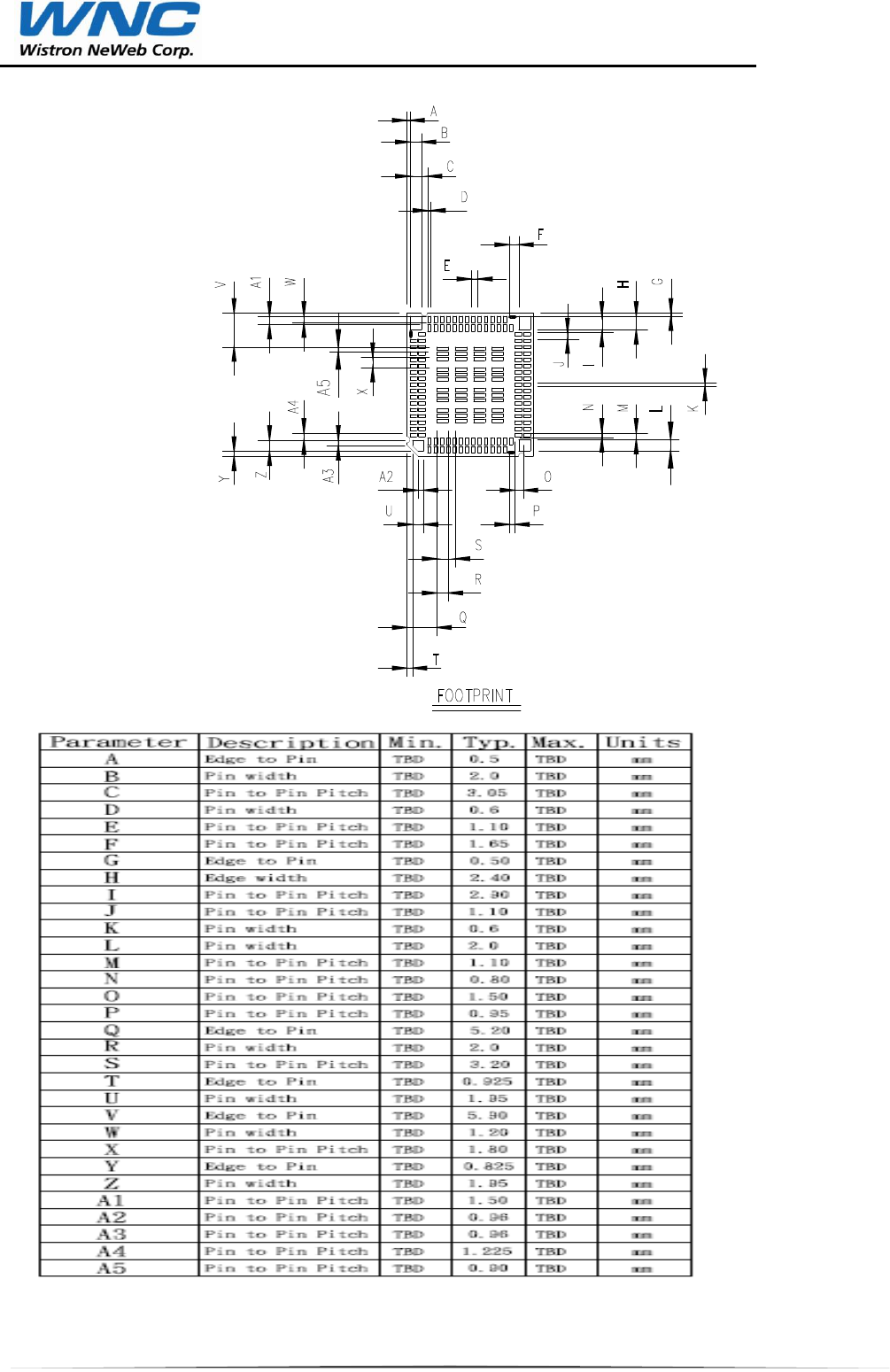
Product specification
21
Figure 7-1-2 Recommended Footprint of SFF Module
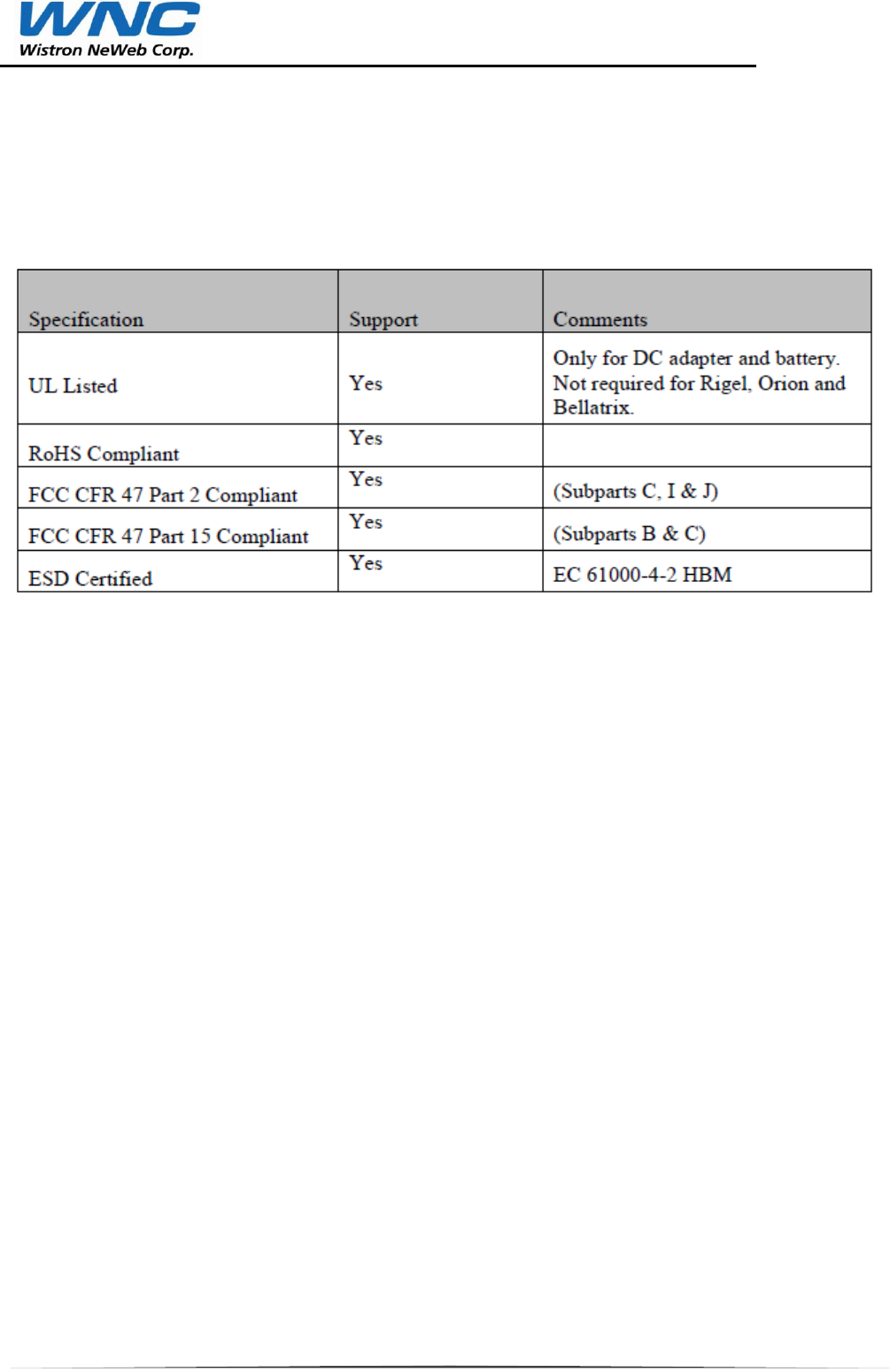
Product specification
22
8 Certification Requirements
8.1 Carrier Certification Requirements
The SFF Development Kit will be used to demonstrate Safe for Network (SFN) compliance for the SFF module on
selected cellular carriers.
8.2 Regulatory Compliance 5
8.3 FCC warning statement
FCC Regulations:
This device complies with Part 15 of the FCC Rules. Operation is subject to the following two conditions: (1) This device
may not cause harmful interference, and (2) this device must accept any interference received, including interference that
may cause undesired operation.
This equipment has been tested and found to comply with the limits for a Class B digital device, pursuant to Part 15 of the
FCC Rules. These limits are designed to provide reasonable protection against harmful interference in a residential
installation. This equipment generates, uses and can radiate radio frequency energy and, if not installed and used in
accordance with the instructions, may cause harmful interference to radio communications. However, there is no guarantee
that interference will not occur in a particular installation. If this equipment does cause harmful interference to radio or
television reception, which can be determined by turning the equipment off and on, the user is encouraged to try to correct
the interference by one of the following measures:
- Reorient or relocate the receiving antenna.
- Increase the separation between the equipment and receiver.
- Connect the equipment into an outlet on a circuit different from that
to which the receiver is connected.
- Consult the dealer or an experienced radio/TV technician for help.
FCC Caution: Any changes or modifications not expressly approved by the party responsible for compliance could void the
user's authority to operate this equipment.
This transmitter must not be co-located or operating in conjunction with any other antenna or transmitter.

Product specification
23
Radiation Exposure Statement:
This equipment complies with FCC radiation exposure limits set forth for an uncontrolled environment. This equipment
should be installed and operated with minimum distance 20cm between the radiator & your body.
This device is intended only for OEM integrators under the following conditions:
1) The antenna must be installed such that 20 cm is maintained between the antenna and users, and the antenna gain
allowed for use with this device is 2 dBi.
2) The transmitter module may not be co-located with any other transmitter or antenna.
As long as 2 conditions above are met, further transmitter test will not be required. However, the OEM integrator is still
responsible for testing their end-product for any additional compliance requirements required with this module installed
IMPORTANT NOTE: In the event that these conditions can not be met (for example certain laptop configurations or co-
location with another transmitter), then the FCC authorization is no longer considered valid and the FCC ID can not be
used on the final product. In these circumstances, the OEM integrator will be responsible for re-evaluating the end product
(including the transmitter) and obtaining a separate FCC authorization.
End Product Labeling
This transmitter module is authorized only for use in device where the antenna may be installed such that 20 cm may be
maintained between the antenna and users. The final end product must be labeled in a visible area with the following:
“Contains FCC ID: NKRUMC-6270Q”. The grantee's FCC ID can be used only when all FCC compliance requirements
are met.
Manual Information To the End User
The OEM integrator has to be aware not to provide information to the end user regarding how to install or remove this RF
module in the user’s manual of the end product which integrates this module.
The end user manual shall include all required regulatory information/warning as show in this manual.